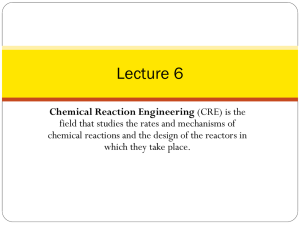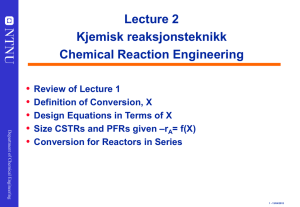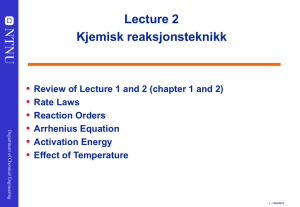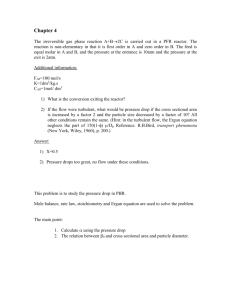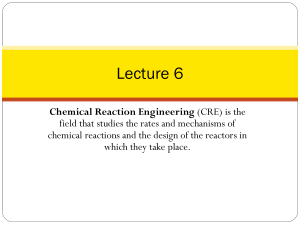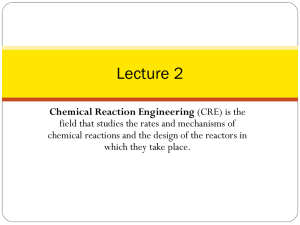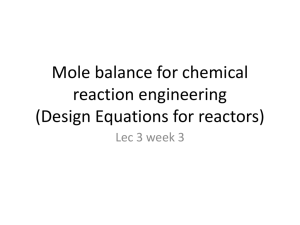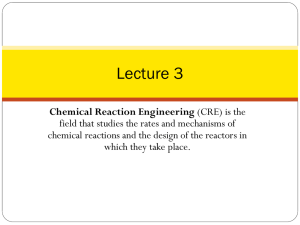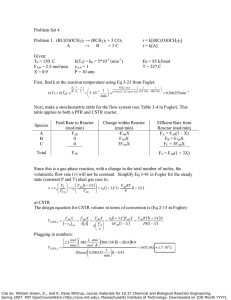Chapter 2
advertisement
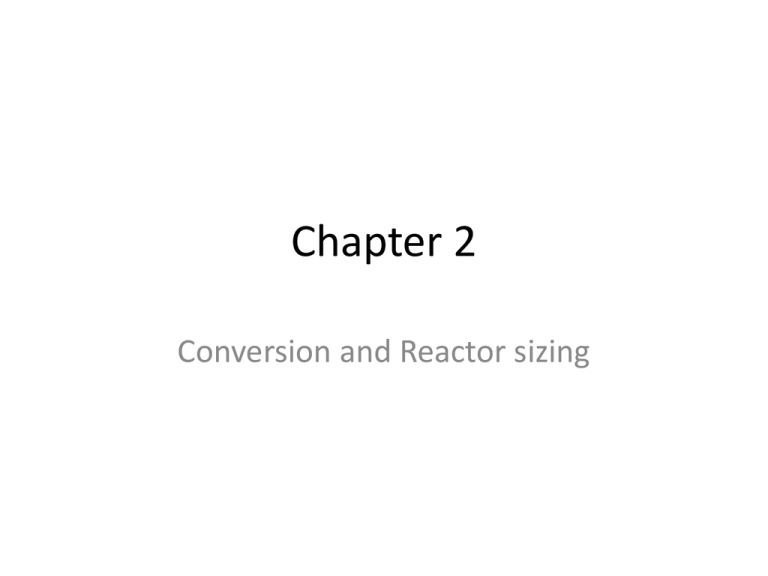
Chapter 2 Conversion and Reactor sizing Overview • In the first chapter the general mole balance was derived for different reactors • In this chapter, these equations are used to size CSTR and PFR using “Conversion” • Value and overall conversion of CSTR and PFR arranged in series 2.1 Definition of Conversion • Conversion is the number of moles of reactant A (limiting reactant) that has been reacted per mole of A fed to the system mole of A reacted XA mole of A fed • For irreversible XA=1 complete conversion • For reversible Xmax=Xe equilibrium conversion 2.2 Batch Reactor Design Equation • After time t, the number of moles of A remaining is N A N A0 N A0 X N A0 (1 X ) d N A0 (1 X ) dN A dX rAV N A0 dt dt dt dX N A0 rAV dt differential form • Batch reactor design equation used for reaction rate data analysis t X X N A0 dX dX 0 dt 0 rAV t N A0 0 rAV Integral form • This equation gives the time required to achieve a specified conversion X • The longer the reactants are left in the reactor, the greater the conversion 2.3 Design equation for flow reactor • Mole balance for reactant A around the reactor • In liquid phase CA0 is the solution molarity (moles/volume) FA0 FA FA0 X 0 A consumed FA FA0 (1 X ) FA0 C A00 • In gas phase C A0 PA0 y A0 P0 RT0 RT0 ideal gas law CSTR • The mole balance for CSTR yields FA0 FA0 FA V rA FA0 FA0 (1 X ) FA0 X V rA (rA )exit FA • This equation calculates the CSTR volume necessary to achieve a specified conversion X • Because of perfect mixing, the exit conc is identical to the conc inside the reactor and the reaction rate is evaluated at the exit conditions Levenspiel CSTR Plot Volume = Area of rectangle 2.3.2 Tubular Flow Reactor (PFR) • No gradient change in T, CA & -Ra • The reactants are consumed as they enter and flow axially down the reactor dFA rA dV d ( FA0 (1 X )) rA dV dX FA0 rA dV V X Differential form of design for PFR X FA0 dX dX dV F 0 0 rA A0 0 rA Integral form • used to calculate volume required to achieve specified conversion X Levenspiel PFR Plot Volume= area under the curve 2.3.3 Packed Bed Reactor • Packed bed reactors are analogous to PFR • Differential form of the design equation used to analyze the reactor pressure drop FA 0 dX r ' A dW • Integral form used to determine the catalyst weight in the absence of pressure drop When P 0 X 0 W 0 X dX r'A 0 W FA0 Applications of the design equations • We can size the reactor from the reaction rate, as a function of conversion • For the first order r kC kC (1 X ) A A A0 1 1 1 rA kCA0 1 X • For irreversible reactions of greater than zero order X 1,rA 0, thus, 1 and V rA • For reversible reactions 1 X X e ,rA 0, thus, and V rA 2.5 Reactors in series • For reactors in series where no side stream either fed or withdrawn, the conversion at point i is defined as Total moles of A reacted up to po int i Xi Moles of A fed to the first reactor • The molar flow rate at point i is given by FAi FA0 FA0 X i FA0 FA1 i=1 X1 FA2 i=2 X2 FA3 i=3 X3 2.5.1 CSTR in Series • For 2 CSTR in series 1 V1 FA0 rA FA0 FA1 i=1 X1 X 1 FA1 FA2 ( FA0 FA0 X 1 )( FA0 FA0 X 2 ) V2 rA2 rA2 FA0 V2 ( X 2 X1) rA2 -rA1 -rA2 FA2 i=2 X2 Levenspiel CSTR Plot Volume of CSTR2 Volume of CSTR1 For the same overall conversion, the total volume for 2 CSTRs in series is less than that required for one CSTR CSTR and PFR Comparison • PFR can be modeled with a large number of CSTRs in series. This concept can be used in – Catalyst decay in packed bed reactors – Transient heat effects in PFRs V5 1 2 3 4 5 V4 V1 V2 V3 1 2 3 4 5 Reactor Mole Balance Summary
